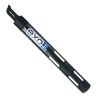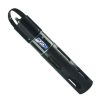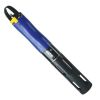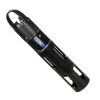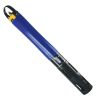YSI EXO Turbidity Sensor
The YSI EXO turbidity sensor is a digital smart sensor featuring welded titanium construction and wet-mateable connectors.
Features
- 0 to 4000 FNU measurement range
- T63<2 sec response time
- 0.3 FNU or ±2% of reading accuracy from 0 to 999 FNU
- Free ground shipping
- Expedited repair and warranty service
- Lifetime technical support
- More
Overview
The EXO turbidity sensor is a digital smart sensor featuring welded titanium construction and wet-mateable connectors. For long-term, in situ continuous monitoring of turbidity, the EXO2 sonde has a wiper to clean the turbidity sensor to avoid sensor fouling and maintain accuracy.
Mechanics
Turbidity is the indirect measurement of the suspended solid concentration in water and is typically determined by shining a light beam into the sample solution and then measuring the light that is scattered off of the particles which are present. The suspended solid concentration is an important water quality factor and is a fundamental measure of environmental change. The source of the suspended solids varies in nature (examples include silt, clay, sand, algae and organic matter), but all particles will impact the light transmittance and result in a turbidity signal.
Customizable
The EXO Turbidity sensor employs a near-infrared light source and detects scattering at 90 degrees of the incident light beam. According to ASTM D7315 method, this type of turbidity sensor has been characterized as a nephelometric near-IR turbidimeter, non-ratiometric. This method calls for this sensor type to report values in formazin nephelometric units (FNU). FNU is the default calibration unit for the EXO sensor, but users are able to change calibration units to nephelometric turbidity units (NTU), raw sensor signal (RAW), or total suspended solids (TSS).
In The News
YSI EXO3s: The Latest in Water Quality Monitoring
The YSI EXO3s offers the latest in multi-parameter water quality monitoring equipment that has a comprehensive list of smart sensors. With an external power source, this sonde is a cost-effective, compact EXO that has the same capabilities as the EXO3 . The sonde is built to last with resilient materials and backed with vigorous testing. The device has five ports for available YSI EXO smart sensors or central wiper. It seamlessly integrates with a data logger to collect and push valuable data to the cloud for access from a PC or mobile device. This small sonde is exceptional for both sampling and continuous monitoring applications.
Read MoreTwo autonomous underwater vehicles launch in Lake Ontario
Two autonomous underwater vehicles are drifting through Lake Ontario, monitoring a slew of environmental metrics, according to a release from New York Sea Grant. The high-tech equipment is recording data on fish productivity, food web changes and algae levels. Each AUV weighs 42 pounds, is six and a half feet long and has a slew of sensors, including side scan sonar and 10-beam Doppler. Mapping capability complements collected parameters like temperature, turbidity, pH and levels of oxygen and phosphorus, among others. The research is made possible through the Cooperative Science Monitoring Initiative between the US and Canada called for under the Clean Water Act of 1972.
Read MoreSensors to help sort out Storm Lake's sediment issues in Iowa
Wind probably isn’t the first thing that people think of when considering causes of poor water quality, but sediment disturbances caused by the combination of shallow waters and high winds are threatening the health of Iowa’s Storm Lake. Although Storm Lake looks picturesque from a distance, the resuspension of sediment is affecting water clarity and exposing harmful nutrients in the water. Led by Clayton Williams and John Downing, professors in Iowa State University’s Department of Ecology, Evolution and Organismal Biology, a research team has begun monitoring the lake to determine the causes and potential solutions to the lake’s sediment issues.
Read More






